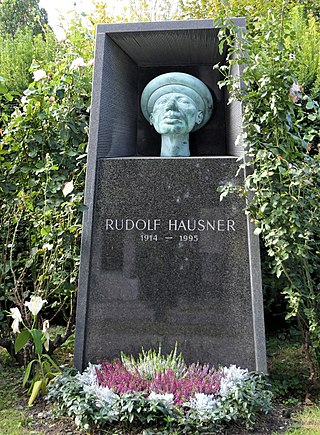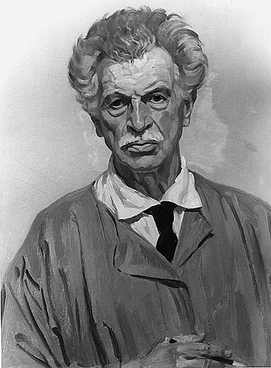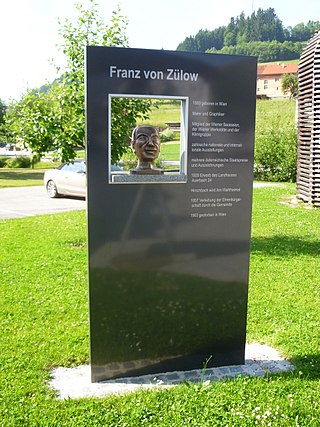
The Vienna Secession is an art movement, closely related to Art Nouveau, that was formed in 1897 by a group of Austrian painters, graphic artists, sculptors and architects, including Josef Hoffman, Koloman Moser, Otto Wagner and Gustav Klimt. They resigned from the Association of Austrian Artists in protest against its support for more traditional artistic styles. Their most influential architectural work was the Secession exhibitions hall designed by Joseph Maria Olbrich as a venue for expositions of the group. Their official magazine was called Ver Sacrum, which published highly stylised and influential works of graphic art. In 1905 the group itself split, when some of the most prominent members, including Klimt, Wagner, and Hoffmann, resigned in a dispute over priorities, but it continued to function, and still functions today, from its headquarters in the Secession Building. In its current form, the Secession exhibition gallery is independently led and managed by artists.

In art history, secession refers to a historic break between a group of avant-garde artists and conservative European standard-bearers of academic and official art in the late 19th and early 20th century. The name was first suggested by Georg Hirth (1841–1916), the editor and publisher of the influential German art magazine Jugend (Youth), which also went on to lend its name to the Jugendstil. His word choice emphasized the tumultuous rejection of legacy art while it was being reimagined.

Prince Ernst of Hohenberg was the second son of Archduke Franz Ferdinand of Austria and his morganatic wife Sophie, Duchess of Hohenberg, who were assassinated at Sarajevo in 1914.

Rudolf Hausner was an Austrian painter, draughtsman, printmaker and sculptor. Hausner has been described as a "psychic realist" and "the first psychoanalytical painter".

The Hagenbund or Künstlerbund Hagen was a group of Austrian artists that formed in 1899. The group's name derived from the name Herr Hagen, the proprietor of an inn in Vienna which they frequented.

Albin Egger-Lienz was an Austrian painter known especially for rustic genre and historical paintings.

Alfred Hrdlicka was an Austrian sculptor, painter, and professor. His surname is sometimes written Hrdlička.

Josef Hoffmann was an Austrian-Moravian architect and designer. He was among the founders of Vienna Secession and co-establisher of the Wiener Werkstätte. His most famous architectural work is the Stoclet Palace, in Brussels, (1905–1911) a pioneering work of Modern Architecture, Art Deco and peak of Vienna Secession architecture.
Art-Club was an association of artists during the postwar period in Vienna, Austria, in 1946–1959.

Erwin Puchinger was a Viennese painter, illustrator, industrial designer and graphic artist. He was an influential figure in Viennese art in the fin-de-siecle. Puchinger was a part of the Austrian Jugendstil and Gesamtkunstwerk movements, which sought to erase the boundaries between fine art and applied art. Puchinger worked in London, Prague and Paris as well as Vienna and collaborated with other major figures in Viennese art and design such as Ernst and Gustav Klimt and Otto Prutscher. He was a respected art professor at the Graphic Arts Institute, where he taught for more than thirty years. His work was also part of the painting event in the art competition at the 1936 Summer Olympics.

Schottengymnasium is an independent Catholic gymnasium with public status in the First District of Vienna. The school was founded in 1807 by imperial decree, and is considered one of the most prestigious schools in Austria. Alumni of the school include three Nobel laureates, several notable politicians, monarchs, artists and scientists.

Leopold Forstner was an artist who was part of the Viennese Secession movement, working in the Jugendstil style, focusing particularly on the mosaic as a form.

Ernst Stöhr was an Austrian painter, graphic artist, writer and amateur musician; one of the founding members of the Vienna Secession.

Ferdinand Andri was an Austrian architect. His work was part of the architecture event in the art competition at the 1936 Summer Olympics.
Heinrich Krause was an Austrian painter known for his contributions to still-life painting. His work played a significant role in Austrian art, particularly between the two World Wars. When art was included as an Olympic event, he competed at the 1936 Summer Olympics and the 1948 Summer Olympics.
Heinrich Rieger was an Austrian dentist whose art collection was one of the most important in Austrian modern art. Rieger and his wife were murdered in the Holocaust.

Franz von Zülow was an Austrian graphic artist and painter whose experimentation resulted in several new printing and design methods. He was a member of the Vienna Secession, the Wiener Werkstatte, and the Zinkerbach Artist Colony. He is the brother of the ceramicist Maria von Zülow and the father of the architect and painter Franz Joachim Zülow.
Paul Mathias Padua was an Austrian-born German painter. He was committed to the tradition of the realist painter Wilhelm Leibl, which was highly valued by Adolf Hitler, and was very successful as an official artist at Nazi Germany.
Josef Jungwirth was an Austrian impressionist painter and professor at the Academy of Fine Arts Vienna.













